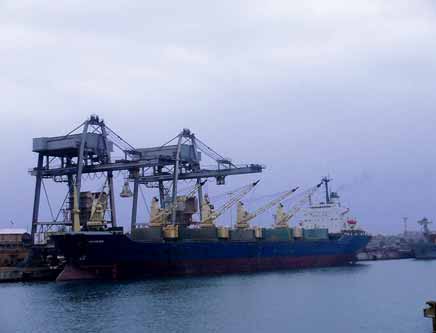
Indian dry bulk cargo ports with berths dedicated to handling iron ore shipments have fallen victim to the federal government making it increasingly difficult to export the mineral by way of imposing a stiff duty of 30% on both lump ore and fines. Disincentive by way of high duty beside, the government is charging a penal 3.6 times more railway freight when the mineral is sent from mines to ports for exports than to destinations within the country for use by local steelmakers. As the voice of the powerful steel lobby has prevailed over the government much to the discomfiture of the miner fraternity, India’s iron ore exports fell rapidly from 117.4mt (million tonnes) in 2009/10 to 97.66mt in 2010/11 and 61.8mt last year. Director general of the Federation of Indian Mineral Industries RK Sharma says in the first quarter ended June 2012, exports on a year-on-year basis were down 45% to 11.93mt from 21.65mt. As a result, every single Indian port through which iron ore is routed to the world market is nursing huge idle capacity.
Local cost push on government account has also significantly eroded the competitiveness of Indian ore. This has coincided with global fall in demand for the mineral and significant loss in its prices. Sharma points out that “sputtering demand for iron ore in the world market sent prices of the benchmark ore with 62% iron content to $82 a tonne in August-end, a fall of more than 50% on a year-on-year basis. In the process, the mineral used in the making of steel fared worst since October 2011.” Brokers desperately looking for a good news break that would lift the market sentiment, therefore, hang on to Beijing clearing some major infrastructure projects to claim investments of $158 billion. Though there was no clarity as to when the announced infrastructure projects will create extra demand for steel, the brokers lifted ore prices to $100 a tonne and beyond immediately on the Chinese announcement. Ore prices, however, fell thereafter and the forecast is that prices will be yo-yo-ing within a short range, at least till the quarter beginning October when China will start restocking in anticipation of winter dislocations in port operations.
China alone accounts for over 90% of India’s ore export sales. In fact, of last year’s export sales of 61.80mt, China’s share was 57.84mt or 93.59%. In a move to reduce its import dependence on Rio Tinto, BHP Billiton,Vale and Fortescue, China had India on its radar, as it is already buying and opening mineral assets in some African countries. However, rises in the Indian tariff barrier from nil (till November 2009) to 30% and high railway charges have left China distraught. China buying less and less from India Paradip Port.
resulted in iron ore cargo movement at Goa falling to 10.39mt in the first quarter of 2012/13 from 14.52mt in the corresponding period of 2011/12. In the same period, Paradip Port suffered a setback to 310,000 tonnes from 269,000 tonnes and Haldia to 370,000 tonnes from 153,000 tonnes.
According to Paradip Port chairman SAC Bose, it is mainly on account of a large shortfall in iron ore traffic that total cargoes — dry bulk, crude oil and container — handled by the all- weather port in the east coast were down 1.8mt to 54.2mt in 2011/12 .Thanks to export discouragement and strict vigilance on mining, iron ore throughput loss for Paradip last year was 7.3mt to 6.55mt. The port handled 16.16mt of ore in 2009/10. Contraction in ore exports has hit the Dhamra Port in the east coast between Haldia and Paradip ports the hardest. The first phase of Dhamra with two fully mechanized berths of 350 metres each with combined capacity of 25mt for handling imports of coal and limestone and exports of iron ore was commissioned in September last year. With iron ore exports drying up fast, the Dhamra berth is lying largely unused. The situation is so grave that the promoters of Dhamra Port have appointed a merchant banker to find a buyer for the ore export berth. CEO Santosh Kumar Mohapatra says: “It’s a strategic move. If someone else sees greater value in running the terminal as export facility, then why not.” The sale of export terminal will be structured through a sub-lease agreement involving payment of upfront money by the buyer and sharing a portion of annual revenue by it with Dhamra Port. In the meantime, a few ports, including Ennore have started using iron ore berths to handle coal.
Kunal Bose